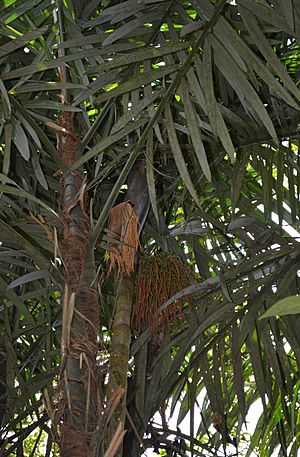Oenocarpus bacaba facts for kids
Quick facts for kids Oenocarpus bacaba |
|
|---|---|
 |
|
| Scientific classification | |
| Genus: |
Oenocarpus
|
| Species: |
bacaba
|
The Oenocarpus bacaba is a very important palm that grows in South America and the Amazon rainforest. It has tasty fruits that people love to eat. This tall palm can grow up to 20–25 meters (about 65-82 feet) high and its trunk can be 15–25 centimeters (about 6-10 inches) wide. It likes to grow in sandy soil that drains water well, especially in the Amazon area. The famous botanist Carl Friedrich Philipp von Martius wrote about this plant in his book Flora Brasiliensis.
Contents
What it's Called: Names of the Bacaba Palm
This palm has many different names depending on where you are!
- In Brazil, people call it bacaba açu, bacaba-de-leque, or bacaba verdadeira.
- In Peru, it's known as ungurauy.
- If you're in French Guiana, you might hear it called camon.
- In Suriname, it's koemboe.
- And in Colombia, it goes by manoco or punáma.
The Portuguese word "bacaba" and the Spanish word "milpesos" (or "palma milpesos") often mean this specific palm. However, sometimes these names are used for other types of Oenocarpus palms too. In English, it's sometimes called the Turu palm.
Delicious Fruit: What the Bacaba Produces
The bacaba palm is amazing because it produces more fruits than almost any other palm in the central Amazon!
- Each bunch of fruit usually has around 2,500 fruits.
- These bunches often weigh about 3–4 kilograms (about 6.6-8.8 pounds), but some can be as heavy as 10 kilograms (about 22 pounds)!
- Each fruit is small, weighing up to 3 grams.
- The fruit has a round, dark red to purple skin.
- Inside, the flesh is creamy white and full of a pale yellow oil.
People in the Amazon often cook bacaba fruits to make a juice. It's very popular, even though it's usually not as famous as açaí juice. The taste of bacaba fruit is very pleasant and reminds some people of avocado.
Fruit Nutrients: Healthy Goodness
Bacaba fruits are packed with natural plant compounds called phenols. These include special ones called flavonoids, which are known for being good for you. The red color of the fruit comes from natural pigments called cyanidin hexosides.
Growing Bacaba: Cultivation and Life Cycle
The bacaba palm grows best in sandy soils that drain water well, which are common in the Amazon basin.
- To help the seeds grow, they should be planted about 2 centimeters (less than an inch) deep in a mix of sand and vermiculite.
- The best temperature for the seeds to sprout is around 30°C (86°F).
- It's important to keep the seeds moist, but not too wet.
- Seeds usually take about 60–120 days to sprout.
- The young trees grow slowly.
- The palm starts producing fruit when it is about 3–4 meters (10-13 feet) tall, which usually takes about 6 years.
Other Uses of the Bacaba Palm
The bacaba palm is useful in many ways, not just for its fruit!
- The seeds and the leftover pulp from making juice are often fed to farm animals like pigs and chickens.
- The leaves of the palm are used to decorate the inside of houses.
- The strong wood from the tree trunks is used for building things.
Place Names Inspired by Bacaba
The bacaba palm is so important that it has even given its name to cities!
- The capital city of Amapá, called Macapá, got its name from a word in the Tupi language, "macapaba." This means "place of many bacabas."
- The city of Bacabal in Maranhão was also named because there were so many bacaba fruits growing there.
See also
 In Spanish: Milpesillo para niños
In Spanish: Milpesillo para niños

